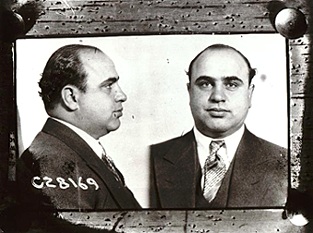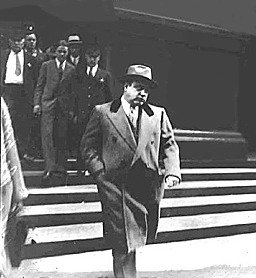Journal 8
Gangsters
History 120
Mahmoud Lababidi
Al Capone


Al Capone was born on January 17, 1899, in Brooklyn, New York. He grew up in a rough neighborhood and was a member of two "kid gangs.” Although he was bright, Capone quit school in the sixth grade at age fourteen and worked various jobs as a store clerk and in a bowling alley. He became part of the notorious Five Points gang in Manhattan and worked in gangster Frankie Yale's Brooklyn dive, the Harvard Inn, as a bouncer and bartender. While working at the Inn, Capone received his infamous facial scars and the resulting nickname "Scarface" when he insulted a patron and was attacked by her brother.
 Capone leaving court
Capone leaving court
Capone later worked his way up in the crime ring to become the number two man of Joe Torrio. Torrio was later shot by a rival gang member and Capone then took over the outfit and became the boss. Capone was well liked by his people. They trusted and obeyed him and called him “The Big Fellow.” Capone actually turned out to be better than Torrio, raking in an income of $100,000,000 a year from 1925 to 1930. The outfit's men liked, trusted, and obeyed Capone, calling him "The Big Fellow." He quickly proved that he was even better at organization than Torrio, syndicating and expanding the city's vice industry between 1925 and 1930. Capone controlled speakeasies, bookie joints, gambling houses, brothels, horse and race tracks, nightclubs, distilleries and breweries at a reported income of $100,000,000 a year. He even acquired a sizable interest in the largest cleaning and dyeing plant chain in Chicago. Although he had been doing business with Capone, the corrupt Chicago mayor William "Big Bill" Hale Thompson, Jr. decided that Capone was bad for his political image. Thompson hired a new police chief to run Capone out of Chicago and he landed in Palm Island, Florida in 1928.
 Capone with Mayor Thompson
Capone with Mayor Thompson
Though Capone was on top of the powerful crime ring, he was indicted by the government for failing to pay his income taxes. He had never filed income tax due to the popular belief that gambling income was non-taxable. Judge James H. Wilkerson sentenced him to a total of ten years in federal prison and one year in the county jail. In addition, Capone had to serve an earlier six-month contempt of court sentence for failing to appear in court along with paying numerous fines. In May 1932, Capone was sent to Atlanta, the toughest of the federal prisons, to begin his eleven-year sentence. Even in prison Capone took control, obtaining special privileges from the authorities such as furnishing his cell with a mirror, typewriter, rugs, and a set of the Encyclopedia Britannica. Because word spread that Capone had taken over in Atlanta, he was sent to Alcatraz. There were no other outfit members in Alcatraz, and security was so tight that he had no knowledge of the outside world. He was unable to control anyone or anything and could not buy influence or friends. In an attempt to earn time off for good behavior, Capone became the ideal prisoner and refused to participate in prisoner rebellions or strikes. While at Alcatraz, he exhibited signs of syphilitic dementia. Capone spent the rest of his felony sentence in the hospital. On January 6, 1939, his prison term expired and he was transferred to Terminal Island, a Federal Correctional Institution in California, to serve his one-year misdemeanor sentence. He was finally released on November 16, 1939, but still had to pay fines and court costs of $37,617.51. After his release, Capone returned to his home in Palm Island where the rest of his life was relaxed and quiet. His health kept deteriorating until on January 25, 1947, he died from cardiac arrest while having pneumonia.
 The jury that convicted Capone
The jury that convicted Capone
Many images found on the internet of Al Capone were on the extremes of his character. Some pictures depicted gruesome slayings like the 1929 Valentine’s Day Massacre. Other pictures portrayed Capone being gentle to the poor by providing them a soup kitchen. The captions are very remarkable as to how each one differs from the other. One caption would describe the evilness in Capone, while another would describe Capone’s kind heart. But moreover these captions tried to depict the hard times during the Depression by displaying the cruel lifestyle people were living just to get by, including that of Capone’s. Although Capone was filthy rich, times were still hard. Capone used illegal means to make his life manageable, but he still had to work hard to do so.
 Capone's Soup Kitchen
Capone's Soup Kitchen
Capone is the typical 1930’s stereotype of the typical gangster. America did not condone his actions of his business, but he was able to get away with a lot of crime. Americans understood it was bad to be a gangster but whenever a gangster could be a benefit to them, they would take the opportunity to use such help, because a gangster was almost the last resort. A typical example would be if a man owning a restaurant needed a loan, he would receive a loan or gift from a gangster, but he would have to pay the gangster back by doing deeds for him such as serve him or his posse at any time. This would almost be a bargain for the restaurant owner because with the loan he could pay of his debts and gain more business. Though most gangster situations were more severe and illegal, they still provided help, such as Capone’s soup kitchen for the poor. Though gangsters were depicted as the bad guy in Americans’ imagination, but in reality they were actually much use to society.